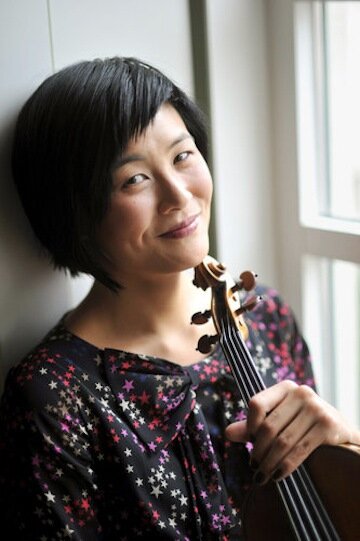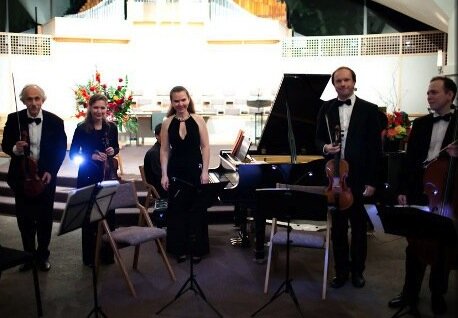A few pieces into violinist Hilary Hahn‘s recital at the University of Washington, my companion leaned over and whispered in amazement, “Her tone is like clarified butter!” Indeed, Hahn’s sound is gloriously full and smooth — anything but gritty. When combined with her exacting technique and musical poise, it all adds up to the very picture of a master violinist at the top of her game.
A touring soloist since her teenage years, the 34-year old Hahn first gained attention for her interpretations of the classics, especially Bach. Recently, she’s expanded her musical horizons, pushing beyond the traditional classical canon. In 2012, she recorded an album of improvisations with German composer Hauschka, who’s known for his pared-down soundscapes featuring prepared piano.
Hahn’s latest recording project is In 27 Pieces: The Hilary Hahn Encores. The album features twenty-six short pieces commissioned from an illustrious list of composers including Nico Muhly, Jennifer Higdon, and Mason Bates. Hahn’s open contest to find the 27th encore drew a pool of more than 400 submissions from around the world.
Last week, Hahn visited Seattle for a UW World Series recital with pianist Cory Smythe. The April 29 concert at the UW’s Meany Hall for the Performing Arts paired repertoire by Mozart, Schubert, and Telemann with new pieces by living composers Antón García Abril and Richard Barrett, commissioned as part of Hahn’s encores project.
Speaking from the stage, Hahn introduced the pieces on the program, providing background and explaining her connection to each work. She’s an affable speaker, never talking down to the audience. Instead, Hahn’s intelligent commentary felt like an invitation to join her in her musical world.
Like her speaking, Hahn’s playing is a reflection of her personality. Calm and collected, Hahn brings a sense of understated warmth to her music. Her playing always feels firmly planted on the ground, radiating emotion instead of gushing passion.
Standing alone on Meany Hall’s immense stage, Hahn began Telemann’s Fantasia No. 6 in E Minor by creating an atmosphere of calculated melancholy. Though she took small liberties in tempo throughout the solo work’s four movements, these moments all made sense and felt completely natural. After listening to Hahn perform Telemann, it’s easy to understand why she first made her name as a Bach player. Her understated brand of musical expression brings a graceful emotionality to the Baroque style.
Spanish composer Anton Garcia Abril’s Third Sigh blends a variety of musical styles. Some harmonies recall Bartok’s beloved Hungarian folk tunes, while others evoke jazzy Gershwin tunes. Commissioned by Hahn for In 27 Pieces, Third Sigh begins with a flurry of extended violin trills that evolve into soaring melodies. At times giddy, at times grave, the work strings together beautiful phrases that flow one after another. It’s all very nice-sounding, but in the end doesn’t seem to add up to any greater statement.
“Sweet” and “tender” aren’t adjectives typically associated with Arnold Schoenberg’s work. Yet Hahn and Smythe’s performance of the Phantasy for Violin and Piano was full of unexpected sweetness and fleeting tender moments. “It’s not about each note,” said Hahn in her introduction to the piece. “It’s about the gesture. It can be spiky, but it can also be lyrical and ethereal.” There were certainly plenty of spiky moments as Hahn and Smythe exchanged volleys of notes. The musical conversation between the duo could have been enhanced by a sharper tone in the piano.
Violin and piano found an ideal balance during Mozart’s Sonata for Violin and Piano in A Major. The two-movement work began cheerfully, with Smythe’s bubbling piano lines providing a foundation for Hahn’s buoyant tone. Here Hahn’s playing was the picture of Mozartean elegance, combining the composer’s refined musical style with a dash of wit. In the theme and variations of the second movement, the duo highlighted dramatic changes from major to minor key.
Hahn and Smythe concluded with Schubert’s Fantasia in C Major for Violin and Piano, the most emotionally vulnerable performance of the evening. Here Hahn was at her most dramatic, effectively managing the ebb and flow between storm and sunshine. One impeccably-timed pause cut perfectly into a particularly angst minor key passage like a gasp of breath, seeming to bring time to a halt before dissolving into a sunny major key. Though Smythe’s sensitive accompaniment worked well in lyrical sections, he could have stepped up to better match Hahn’s energy in stormier passages.
Following on the emotional high point of the Schubert, Hahn and Smythe concluded with an encore by British composer Max Richter. The final track on In 27 Pieces, Mercy is a sweetly sentimental work that brought out yet another side of Hahn’s musical personality. Her rich violin tone took on just a hint of longing and raw emotionality, a parting gesture that left me intrigued and wanting to hear more.

